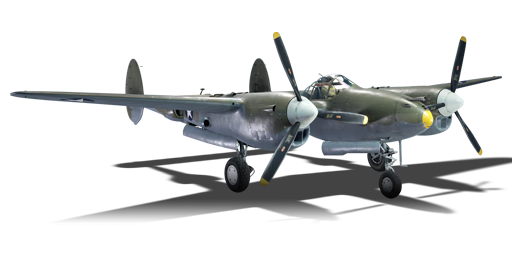


The P-38K was essentially a P-38G airframe fitting with the more powerful V-1710-75/77 engines. These engines could make well over 1600 hp. The P-38K also had better propellers which also helped with the performance. Test flights were conducted in early 1943 and the results were promising. The climb rate was greatly increased and was far better performing compared to America's main fighters at the time (P-47D and the P-51B). However, this idea never reached production due to the extensive time needed to get production ready for an engine change. This also sparked talks about a Merlin-powered P-38 but that was also rejected. Only one prototype was developed.
Introduced as a premium pack during Update 1.53 "Firestorm", the P-38K has the best flight performance out of any P-38 Lightning thanks to its better engines and propellers. It features the standard armament of four 12.7 mm machine guns in the nose along with a single 20 mm cannon. However, this variant lacks any ground attack munitions like some of the other P-38 variants. Nonetheless, it's an excellent aircraft for fighting enemy aircraft thanks to its performance and sufficient armament.
The P-38K was made available for purchase during the 2015 Christmas Sale. It was later available for purchase in the store for the 2016 Independence Day Sale, the 2017 A revolt in War Thunder, the 2017 Summer Sale, and the 2018 Winter sale and has since been made available for various sales and allied themed events.
flaps
flaps
flaps
brake
| Belt | Belt filling | Armor penetration (mm) at a distance: | |||||
|---|---|---|---|---|---|---|---|
| 10 m | 100 m | 500 m | 1000 m | 1500 m | 2000 m | ||
| HEF-I/AP-T | 39 | 36 | 25 | 16 | 10 | 6 | |
| AP-T/AP-T/HEF-I/HEF-I | 39 | 36 | 25 | 16 | 10 | 6 | |
| HEF-I/HEF-I/HEF-I/AP-T | 39 | 36 | 25 | 16 | 10 | 6 | |
| AP-T/AP-T/AP-T/HEF-I | 39 | 36 | 25 | 16 | 10 | 6 | |
| HEF-I | 5 | 4 | 3 | 2 | 2 | 2 | |
| Belt | Belt filling | Armor penetration (mm) at a distance: | |||||
|---|---|---|---|---|---|---|---|
| 10 m | 100 m | 500 m | 1000 m | 1500 m | 2000 m | ||
| API-T/AP/AP/I | 30 | 27 | 20 | 13 | 9 | 6 | |
| AP-I/AP-I/API-T/I/I | 28 | 26 | 18 | 11 | 7 | 4 | |
| API-T/I/AP/AP/AP-I/AP-I | 30 | 27 | 20 | 13 | 9 | 6 | |
| API-T | 28 | 26 | 18 | 11 | 7 | 4 | |
| AP-I/I/AP-I/I | 28 | 26 | 18 | 11 | 7 | 4 | |







 2 x (95 / 245 / 475) %
2 x (95 / 245 / 475) % 
 2 x 172 %
2 x 172 % 

Flight performance | |
|---|---|
Survivability |
|---|
Weaponry |
|---|